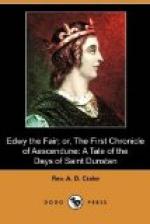All the early chroniclers appear to take a similar view of the character and court of Edred. William of Malmesbury says—“The king devoted his life to God, and to St. Dunstan, by whose admonition he bore with patience his frequent bodily pains, prolonged his prayers, and made his palace altogether the school of virtue.” But although pious, he was by no means wanting in manly energy, as was shown by his vigorous and successful campaign in Northumbria, on the occasion of the attempt to set Eric, son of Harold, on the throne of Northumbria. The angelic apparition to St. Dunstan, mentioned in chapter VII, is told by nearly all the early historians, but with varying details. According to many, it occurred while Dunstan was hastening to the aid of Edred. The exigencies of the tale required a slightly different treatment of the legend.
x Confession in the Anglo-Saxon Church.
“On the week next before holy night shall every one go to his shrift (i.e. confessor), and his shrift shall shrive him in such a manner as his deeds which he hath done require and he shall charge all that belong to his district that if any of them have discord with any, he make peace with him; if any one will not be brought to this, then he shall not shrive him; [but] then he shall inform the bishop, that he may convert him to what is right, if he he willing to belong to God: then all contentions and disputes shall cease, and if there be any one of them that hath taken offence at another, then shall they be reconciled, that they may the more freely say in the Lord’s Prayer, ’Forgive us our trespasses, as we forgive them that trespass against us,’ etc. And having thus purified their minds, let them enter upon the holy fast-tide, and cleanse themselves by satisfaction against holy Easter, for this satisfaction is as it were a second baptism. As in Baptism the sins before committed are forgiven, so, by satisfaction, are the sins committed after Baptism.” Theodulf’s Canons, A.D. 994 (Canon 36).
It is evident, says Johnson, that “holy night” means “lenten night,” as the context shows.
xi Incense in the Anglo-Saxon Church.
Dr. Rock, in his “Hierurgia Anglicans,” states that incense was used at the Gospel. In vol. i., quoting from Ven. Bede, he writes—“Conveniunt omnes in ecclesium B. Petri ipse (Ceolfridas Abbas) thure incenso, et dicto oratione, ad altare pacem dat omnibus, stans in gradibus, thuribulum habens in menu.” In Leofric’s Missal is a form for the blessing of incense. Theodore’s Penitential also affixes a penance to its wilful or careless destruction. Ven. Bede on his deathbed gave away incense amongst his little parting presents, as his disciple, Cuthbert, relates. Amongst the furniture of the larger Anglo-Saxon churches was a huge censer hanging from the roof, which emitted fumes throughout the mass.
“Hic quoque thuribulum, capitellis undique cinctum,
Pendet de summo, fumosa foramina pandens:
De quibus ambrosia spirabunt thura Sabaea,
Quando sacerdotes missas offerre jubentur.”
Alcuini Opera, B. ii,, p. 550.




